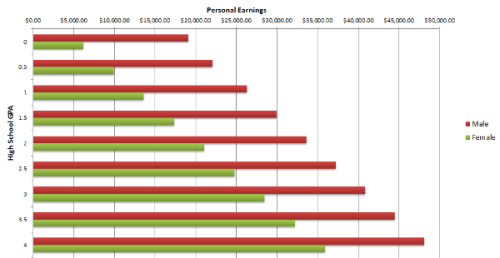#gender equity
Since the dawn of time, or at least the dawn of the GPA, high school students have been hearing that grades matter. Now, a University of Miami study backs up that parental talking point: The better your GPA, the higher your income is likely to be 10 years after graduation.
But as @think-progress points out, this doesn’t mean that girls with good grades earn more than boys with mediocre ones.Quite the contrary, in fact:
A woman who got a 4.0 GPA in high school will only be worth about as much, income-wise, as a man who got a 2.0. A woman with a 2.0 average will make about as much as a man with a 0 GPA.
Other depressing findings: Girls have significantly higher average GPAs, but “men will still end up having significantly higher income later on,” Think Progress says.
And the GPA-gender wage gap continues through college and grad school:
A woman who is one credential ahead of a man will always be worth less in terms of income: a woman with an associate’s degree makes less than a man with a vocational degree, a woman with a bachelor’s makes less than a man with an associate’s, and a woman with an advanced degree makes less than a man with a bachelor’s. Even among recent college graduates with the same grades, majors, and career fields, men will make more in their first jobs.
(Chart via U of Miami)
Post link
Just how difficult is it to be a working parent in the U.S. these days? huffingtonpost has this sobering chart.
The U.S. lags significantly behind other developed countries in key areas such as paid maternity or paternity leave (it’s one of just three countries with no such provision— the other two are Oman and Papau New Guinea), paid family and sick leave, and affordable early childhood education. As a result, notes reporter Laura Bassett, the percentage of women participating in the workforce is relatively low:
In 1990, the U.S. had the sixth-highest female labor participation rate among 22 of the world’s wealthiest countries. Today, the U.S. ranks 17th.
Meanwhile, the White House Council of Economic Advisors has this new report on working families, part of the Obama administration’s ongoing campaign to explore ways of using federal workplace policy to improve the lives (and incomes) of parents and children. Yesterday, the White House hosted a daylong summit on working families, where President Obama told the audience,
“Family leave, child care, workplace flexibility, a decent wage — these are not frills, they are basic needs. They shouldn’t be bonuses. They should be part of our bottom line as a society. ”
Find video of that conference here.
(Infographic by Alissa Scheller for The Huffington Post.)
Post link
If you want to understand why the new Lego female scientist kits are such a big step forward, compare them to earlier Lego efforts to capture the little-girls-who-like-to-build-things demographic. The absence of princess-y pastels and pixie preciousness (not to mention boobs, as in the “rock star” Lego figure above) is awesome.
For more on how the “Research Institute” line came to be, mentalfloss has the scoop here.
(All images via Lego)
Post link
The companies in MoJo’s 2012 dataset: Apple, HP, Intel, Google, Cisco, Oracle, eBay, Facebook, Gilead Sciences, and VMware.
Post link
Sociology for Women
Over on my research blog, The Other Sociologist, I’ve written about How Media Hype Hurts Public Knowledge of Science. I discuss how scientists can better support public education by critiquing poor science reporting in the news. A recent example involved the media reporting that most people think that astrology is a science. This “factoid” came from a large study by the American National Science Foundation, but the results were quoted out of context and needed scientific critique. The broader study actually shows that the public do not really understand what scientists do, how our research is funded and the outputs of our work. This lack of knowledge undermines the public’s general understanding and trust in science. I argued that more scientists can get involved in diverse outreach activities to support public learning. This is part of a long-standing series I’ve been writing on how to improve public science education. Read more my blog.
On Sociology at Work, I talked about How Sociology Class Discussions Benefit Your Career. I used this post to highlight how the group work we do during an undergraduate degree trains students for the types of activities they’ll carry out as applied researchers outside academia. This includes dealing with clients, running community consultations and thinking critically on our feet. Learn more.
The rest of this post is about my most recent writing on gender equality in business and in science and technology.
Post link
And THIS is why sexism in opera isn’t controversial – it’s just a fact.
Find the full study here: https://www.bsomusic.org/stories/the-data-behind-the-2016-2017-orchestra-season/
Post link










